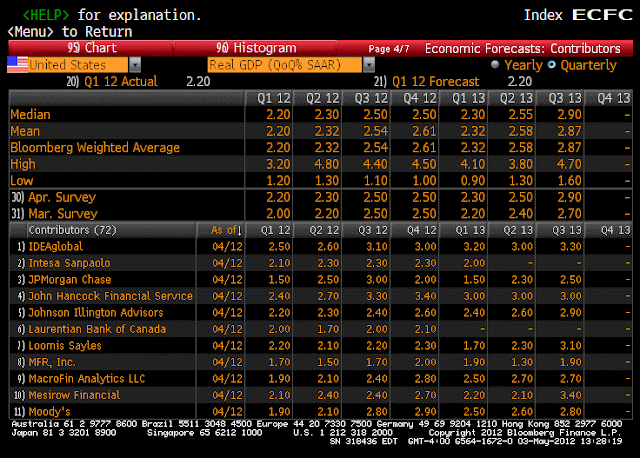GDP - Gross Domestic Product equals the total income of everyone in the economy or the total expenditure on the economy's goods and services. GDP includes only the value final goods and services. In other words, GDP gives us a tell as to whether the economy is growing, slowing or flat lining. This is clearly important to global macro traders as understanding where the economy is moving, or expected to move dictates sentiment in various markets. The latest release for GDP came in on April 27th, where the release was less than expected, with Advanced GDP q/q coming in at 2.2% vs. 2.6% estimates. The equity market faltered slightly when it was released but didn't sell of heavily as traders believed the drop off in GDP was simply fall out from the recent global fears. Let's take a look at GDP forecasts for the coming quarters, taken from leading economists expectations:
As you can see, out of 72 analyst forecasts, the median forecast expects GDP to rise to 2.5% by the end of this year, and a rise to almost 3% by Q3 of 2013. Now obviously these are just forecasts and can drastically change over the coming months, but the bottom line is economists expect the U.S. economy to grow faster as the year continues on.
Above shows GDP forecasts for the Chinese economy. It is important to watch the Chinese economy figures as they can give a great bellwether for global consumption and economic growth. Recently the Chinese economy has been hit due to a variety of reasons, but analysts expect their growth rate to remain steady to moving upwards. Once again, these figures can change drastically in the coming months.
In summary, it appears as though analysts expect the global recovery in the United States to continue, due to a variety of reasons such as:
-Low O/N interest rates
-Jobs market appears to be recovering
-Manufacturing appears to be coming back
-Consumer confidence recovering
-Backing by central banks and governments to prevent another liquidity crisis
I personally believe we will see a flat to upwards movement in U.S GDP in the coming months. I believe the Federal Reserves support will limit any fears of another slowdown.
Inflation - Inflation is a great measure on the health of an economy. Inflation is the change in prices of all goods and services purchased for consumption by urban households and is measured by the CPI index (Consumer Price Index). Typically positive but low inflation is good for an economy, rampant inflation is not good as that devalues a country's currency, and negative inflation (deflation) is not good because drops in prices cause a drop in production -> drop in demand -> economic slowdown.
Currently the federal reserve targets an inflation rate of about 2% YoY. I believe higher inflation may be a better outcome for the economy right now as bonds are yielding extremely low rates and an increase in inflation should cause bond yields to rise. Higher inflation could be caused by the current liquidity injections the federal reserve has been implementing.
This chart shows U.S. CPI YoY dating back to 1987. As you can see, the CPI index has been in a downwards channel, and is currently rising to the 10 year average of around 2%. The amount of money that has been injected in the U.S. financial system (and current debt problems) should cause inflation to move higher, thus causing equities to rise and bonds to fall.
Given the support from the Federal Reserve through liquidity, I expect to see higher inflation in the coming years. I also believe an interest rate hike will be needed, most likely in 2013, as treasuries are unattractive to investors at these levels.
The above chart is the 2 year U.S. treasury note yield. The 2 year is currently yielding .26% and is sitting at lows not seen since the 1950's. The effects of the federal reserves actions, in my opinion, should cause inflationary growth, sending notes lower and riskier assets such as U.S. equity and emerging markets higher.
The main risks to this trade is obviously a slowdown in the U.S. economy, and a continuing crisis in Europe. However, the risk remains low as 2 year yields can't get much lower, and the U.S. equity market will be constantly supported by the federal reserve. My view is that we should see a pullback in equity soon, which should be a great opportunity to purchase risk on assets. A good hedge for now would be to purchase volatility through puts.





No comments:
Post a Comment